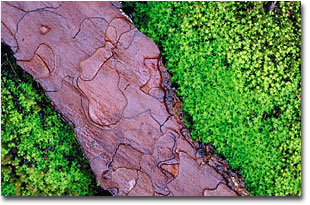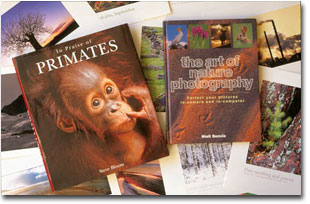|
|
 Why and How to Get Your First Book Published
Text and photography Copyright Niall Benvie
Do you dream of seeing your finest personal work showcased in a large format coffee table book - with handsome financial rewards following? Then dream on, because you can be pretty sure that, for a first book at least, it just isn’t going to happen. There are a few photographers who have bucked the trend but for most of us, entry level into the world of book publishing comes in the form of subject, rather than style-led projects. Specifically, they are more likely to be books about places, people, nature or the ”how-to” of photography itself rather than the photographer’s personal vision of the world. And, unless your name is known to the general public as well as within your profession, it is unlikely that the royalties from the book will set you up comfortably for retirement. Books, if they are any good, are an excellent marketing tool and before committing time to a project, you should consider how you can use it to generate new work and add to your client list. It is a mistake to regard the book as a source of serious income in its own right. A standard 50,000 word how-to book with c150 pictures typically attracts an advance against royalties of about £5000. In effect, you are not even being paid for the pictures at this stage (£100/thousand words is a mid-range editorial rate for magazines) so you will have to make up that income from elsewhere. Moreover, simply writing and editing a book of this length is enormously time-consuming - it takes me about 5 months of doing very little else to complete a project. If the book is successful you can expect, over time, an income from royalties (once the initial advance has been paid off) but on the common 10% of nett receipts deal described below, your publisher may need to move as many as 15,000 books before you begin to receive royalties. Compared to stock income or even article writing for magazines, the return from books, in the short term at least, is poor. Nevertheless, the end product has a longer shelf life and is a more impressive testament to your talent than tearsheets. Just keep in mind who you need to impress as you are writing it; the reader who has paid 50 pence for his copy through a book club is not the one. What every commissioning editor wants What every editor wants, of course, is photography that is fresh and will grip the public’s imagination. The reality is that there is relatively little talent of that calibre out there and it won’t necessarily want to give its time to book production. The fall back position from novelty is safe predictability and, indeed, most of the new titles that appear have antecedents. My publisher, David and Charles, produces a lot of photography, craft and gardening books, as well as a range of children’s titles. They normally work by following trends in a particular field - for example, the current popular interest in digital photography - then commissioning an author to write a book on that topic. They receive surprisingly few unsolicited proposals (one or two a month), but rarely commission by this route. Although both of my titles were unsolicited, I did have a foot in the door already as I had partly “ghost” written one of their earlier photography books after the untimely death of its author. Nevertheless, it took another three years before my first proposal was accepted. Commissioning editors, initially, need only a very brief outline of what the project is about. They want to see a synopsis-to know who the target readership is, what makes the book distinctive from competing titles (no matter how different you think it is, editors don’t always see it that way) and why you are the best person to write and illustrate it. They also want to see samples of your work, but at this stage, that need only be in the form of inkjet prints, layouts or tearsheet. Book dummies are generally a waste of money unless you are able to predict what the next in-house design look will be. Don’t send slides; you risk not getting them back and conscientious editors (I know this for a fact) feel nervous about being responsible for someone’s career-best images. This also means that you can send out the same proposal to several publishers simultaneously, at minimal cost. If, when, the publisher wants to see slides and a sample chapter or two, you will be asked, but don’t commit time and resources before then.
Nothing will ensure a more rapid rejection than pitching an unsuitable title to a publisher, so study the company’s list to see if your idea would fit in with their existing coverage. In selecting potential publishers look too at their backlist. If they have titles on it published 8 or 10 years ago, it means that you have a better chance of getting into royalty receipts before the book is remaindered than one which has nothing older than 3 or 4 years on its backlist. There is also a chance that you can pitch your book on the grounds that they need to update a particular title and you are just the person to do it. This was the approach I took with The Art of Nature Photography and Creative Landscape Photography. It is important to quiz the publisher on their success at striking co-edition deals with other publishers, especially in the US. If US and European deals can be made, prints runs go up, unit costs go down and you are more likely to get a contract. In terms of earnings, however, co-editions are poorer for the author/photographer than a simple overseas distribution deal. Books sold to the foreign publisher (and to book clubs too, for that matter) are discounted by anything up to 80%. If we earned our royalty as a percentage of coverage price, that wouldn¹t matter, but today royalties based on nett publisher receipts are the norm, that is x% of whatever the publisher receives. The level of royalties may vary between 7.5 % for overseas and 10% for domestic sales; 7.5% of 20% of the cover price doesn’t leave much for the photographer; I receive about 30 pence for every book I sell in the US - less than the cost of a mounted frame of Velvia. Striking a deal With this knowledge, you may be less willing to throw yourself at the feet of a publisher just to get you work between hardcovers. It might even make you a little mean and unwilling to accept a contract without determined negotiation. Be assured of one thing; by the time you are offered a contract, the publisher is committed to the project and you are not in as weak a position as you might suppose. However, it usually takes at least one book before this realisation comes.Since one of the main reasons you are wanting a book published is so that you can market your work to new clients, make sure that you can buy your own book cheaply from the publisher, or a least, get a reasonable number of complimentary copies at the outset. Five is the number often offered, with 35% discount or subsequent purchases. Try for a minimum of 20 copies and 45 - 50 % discount. You shouldn’t overlook the possibility of obtaining copies of the drum scans made for your book; these are invaluable for your own promotional materials and can be used to submit images for magazine use at a size similar to that in the book. The scans are being made anyway, so all it needs is for someone at the scanning bureau or in the design department to copy the files you want onto a number of CD’s and you have saved a large amount of money in scanning bills. This one is worth negotiating hard for. Beware too of letting electronic rights go too cheaply; it is unclear how the technology will develop and how wide the uptake will be but if the hype surrounding electronic books for example is being taken seriously by the very publishers promoting them, then the rights should be on a par with those for printed books.
Doing it a different way - the Steve Bloom method Now and again a photographer defies the received wisdom about how to get into books, does it his or her own way and gets results. Wye-based wildlife photographer Steve Bloom did just that with his first book, In Praise of Primates, published by the German house, Könemann, in 1999 with an initial print run of 205,000 copies in 10 languages. “I believe that if you do have something fresh to say, take the risk of committing time and money to pulling the material together, then present the idea enthusiastically to the right publisher, you have a formula for success.” Steve arranged a meeting at the London Book Fair, a trade event which doesn’t normally welcome portfolio-toting hopefuls. After publisher failed to turn up for the meeting, Steve, by chance, met Ludwig Könemann and secured a deal within 10 minutes on the strength of his proposal and sample images. “We made it work because the publisher had faith in the project. Enormous print runs like this are pretty unusual in respect of wildlife portfolio books, but this is how Könemann can sell his product at such a low price. That translates into sales.” Steve’s involvement went beyond a photographer¹s normal remit of shooting the pictures and supplying captions and/ or text. He was also responsible for the design and layout of the book. And, using his own drum scanner, he created press-ready files to Könemann’s repro. house. “This is an area which requires a lot of patience and cooperation. But I would advise anyone publishing a photography book to get on a plane and go to the printers to view proofs as they are being made. My publisher was happy for me to do this because he knew he would probably have a better product if I was satisfied by how the images looked on the page.” In Praise of Primates was a two year project which took Steve all over the world. The end product is proof that, with drive, the right idea, technical grounding and a positive attitude, photographers do not necessarily have to accept low print runs and poor returns. Niall Benvie - NPN 018 Comments on this article? Send them to the editor. |
|
|
 Since book projects generally, but not always, make the photographer very little money, it is ideal if they can be dovetailed with other work. This is one from a series commissioned by the Scottish goverment agency, Scottish Natural Heritage to document the UK's oldest National Nature Reserve: 10 pictures from the job ended up in
Since book projects generally, but not always, make the photographer very little money, it is ideal if they can be dovetailed with other work. This is one from a series commissioned by the Scottish goverment agency, Scottish Natural Heritage to document the UK's oldest National Nature Reserve: 10 pictures from the job ended up in  I have to admit that I regard books as a good place as any to get some of those pictures I like, but which rarely sell, into print. Fortunately, people still buy the books. My publisher has been generous enough to give me completely free-rein on picture selection, something never afforded to magazine photographers.
I have to admit that I regard books as a good place as any to get some of those pictures I like, but which rarely sell, into print. Fortunately, people still buy the books. My publisher has been generous enough to give me completely free-rein on picture selection, something never afforded to magazine photographers.
 Niall Benvie and Steve Bloom took quite different routes to having their first books published but the end result was the same - improved visibility of their work in an over-crowded market place.
Niall Benvie and Steve Bloom took quite different routes to having their first books published but the end result was the same - improved visibility of their work in an over-crowded market place.